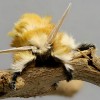 The southern flannel moth is an attractive small moth that is best-known because of its larva, the puss caterpillar, which is one of the most venomous caterpillars in the United States. This 12-page fact sheet was written by Donald W. Hall, and published by the UF Department of Entomology and Nematology, January 2013.
The southern flannel moth is an attractive small moth that is best-known because of its larva, the puss caterpillar, which is one of the most venomous caterpillars in the United States. This 12-page fact sheet was written by Donald W. Hall, and published by the UF Department of Entomology and Nematology, January 2013.
http://edis.ifas.ufl.edu/in976
Tag: Caterpillars
Saddleback Caterpillar Acharia stimulea (Clemens) (Insecta: Lepidoptera: Limacodidae) (EENY522/IN923)
 Acharia stimulea is best known as a medically significant species. Its spines are strong, acutely pointed, and hollow. They embed deeply into tissue and break off, and can interrupt healing as the protoplasm from the venom glands dries into the tissue area. The venom itself can cause a systemic condition called erucism or acute urticaria, for which severe symptoms may include migraines, gastrointestinal symptoms, asthma complications, anaphylactic shock, rupturing of erythrocytes, and hemorrhaging. This 9-page fact sheet was written by Christopher S. Bibbs and J. Howard Frank, and published by the UF Department of Entomology and Nematology, March 2012.
Acharia stimulea is best known as a medically significant species. Its spines are strong, acutely pointed, and hollow. They embed deeply into tissue and break off, and can interrupt healing as the protoplasm from the venom glands dries into the tissue area. The venom itself can cause a systemic condition called erucism or acute urticaria, for which severe symptoms may include migraines, gastrointestinal symptoms, asthma complications, anaphylactic shock, rupturing of erythrocytes, and hemorrhaging. This 9-page fact sheet was written by Christopher S. Bibbs and J. Howard Frank, and published by the UF Department of Entomology and Nematology, March 2012.
http://edis.ifas.ufl.edu/in923
EENY095/IN252 Cabbage Palm Caterpillar, Litoprosopus futilis (Grote & Robinson) (Insecta: Lepidoptera: Noctuidae: Ophiderinae)
Revised! EENY095, a 4-page illustrated fact sheet by G. W. Dekle, is part of the Featured Creatures collection. It describes this larva of the owlet moth that can seriously affect the production of palmetto honey — synonymy, distribution, description, hosts, field observations, economic importance, and management. Includes references. Published by the UF Department of Entomology and Nematology, April 2010.
http://edis.ifas.ufl.edu/in252